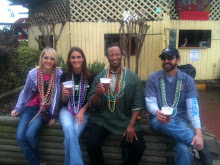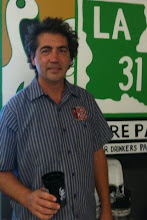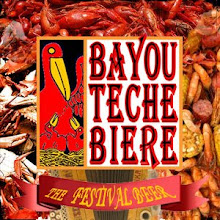Slightly across from our home’s side door is a small grove of bald cypress trees that we planted about thirteen years ago. Along with the live oak trees, crepe myrtles, and Southern Magnolias we transplanted, and a few very old native pecans, our yard is taking on the appearance of a Louisiana themed arboretum. In that small stand of cypress is a single tree whose leaves sprout long before any others even try to. I’ve always taken the arrival of that particular tree’s leaves as a sign of the end of winter.
It also signals the start of pleasant motorcycling weather.
Since our first frost last year, I have squandered away several hours studying that tree for any evidence of the neon-bright green needles that only the earliest-sprouting of springtime cypress trees have. I know the old Cajun folks around Arnaudville had their ways to tell if winter was truly over, my grandparents waited for the pecan tree leaves sprouted before they planted any spring vegetables, and I know some folks wait until they saw their first springtime robin.
But for me and the very non-agrarian pursuits I have intended for my old Harley Springer, the sign I’ve been waiting for is that lone cypress tree’s leaves.
Guess what appeared Monday.
I pulled the cover off of my bike and removed the battery tender – I won’t need that for about nine more months. I replaced the black leather saddle and tightened the nuts that hold it down - checked the oil and air, and then pushed her out onto our gravel driveway.
The sky was that distinctive springtime blue romanticized on the ceilings of countless Southern porches. I fired up the V-twin engine and let her warm. Then after swinging my legs and beer belly over the saddle, I raced down the driveway and made the left turn left towards Opelousas.
Opelousas is one of the oldest towns in Louisiana. During her earliest days of French and then later, Spanish colonial rule, Opelousas was the headquarters of the Poste des Opélousas. During the War Between the States, after Les Americains captured Baton Rouge, Opelousas briefly became the Confederate capitol of the state (before the Yankees chased the state government up to Shreveport). It is because of her significant role in Louisiana’s history that Opelousas has so many significant homes, churches and buildings – and also many great old restaurants serving some of the finest Cajun and Creole food in Acadiana.
However it is not the historic scenery or fine restaurants that lured me to Opelousas on my first ride of year. Opelousas is where the Louisiana State Highway known as LA-31 begins.
Beginning just west of Interstate 49 is the short Opelousas stretch of the highway. A longstanding white metal sign with a reflective green silhouette of Louisiana welcomes me to what here is called the LA-31 Spur. The state highway department is unhurriedly swapping these old green and white signs with more contemporary looking black and white ones. I hope they are not too competent in their efforts; I will miss seeing the occasional old ones.
Opelousas’ LA-31 spur is pretty much the unsurprising in-town stretch of highway strewn with the McDonald’s/Wendy’s/Burger King/Taco Bell/Texaco/Chevron and Shell signs familiar to small towns this close to a major interstate exit. Sputtering east, my old Harley only has to endure three red lights worth of fast food anti-nirvana, a quick duck under I-49, and scooting past a Wal-Mart Supercenter, and she is where she wants to be – in fifth gear on a rural Cajun Highway.
After about a mile I hang a left towards Evangeline Downs. Twisting on the throttle, I roll down the boulevard that leads to the racetrack. Though it is pretty early in the morning there already are a few jockeys leisurely riding their horses. While parking close to the track I wonder who is being warmed up, the jockeys or the quarter-horses.
I walked across the large black-topped parking lot and enter the casino. I buy myself an incredible cup of very dark roasted coffee and am then offered real cream to add to it. Since it is my first cup of what is usually a multi-cup day I drink it very leisurely. I feel obliged to top it off (it is that good) and make my second cup of the day. Though there are slot machine lights flashing and bells continuously dinging, I find the din somewhat relaxing. In the beer business you are often on the road and drinking bad coffee out of a Styrofoam cups is something you have to endure. I sometimes forget how good honest coffee in a cup made of porcelain is.
I lazily meander back across the parking lot watching the riders on their playfully trotting horses. I’ve really got a lot of things to get caught up on at the still-under-construction new and larger brewery, but I decide to watch the jockeys a little while longer. I know I’m the one goofing off, but leaning against the saddle of my iron steed and watching the hard working jockeys seems at the time to be a very productive way to waste much of my morning.
Getting back on the 31, I roll east about another mile or so and then have make a right turn. From now on the highway pretty much follows the Bayou Teche on one bank or another all the way to New Iberia. The Teche was named after the Chitimacha word for snake – their oral tradition is that their warriors had slayed a giant snake whose tail began at from what is now Port Barre and zigzagged all the way to his head in Morgan City. In its death throes the snake wiggled and died – carving out the Bayou now known as the Teche.
For motorcyclists this is interesting story, because that dying snake’s bayou makes for a winding curvy road following her banks. Also, this northern stretch of the LA-31 may be one of the best built highways in Louisiana. She is paved almost as smoothly as the German autobahns – something that is unheard of on the pothole afflicted and patched-up roads of South Louisiana.
I pass farmhouses with Redbud trees and azaleas just starting their springtime bloom, and there are still a few camellias dropping the last of their winter flowers. The lawns of the farmhouses have grass that is that shade of St. Augustine green you only see in early March.
Rolling through Prairie Laurent I pass the first home whose yard has a statue of the Virgin Mary in front. At one time nearly every home in Cajun Louisiana would have had such an outdoor shrine to the Blessed Virgin. Though the area is still devoutly Catholic, we are not as much so as when I was a kid. I will see many more statues of her as I roll south.
The tale is that the Ursuline nuns in New Orleans prayed to the Virgin to deliver us a victory over the British during their invasion of New Orleans during the War of 1812. In their prayers they offered to put up statues of her if we were able to keep the British out. After the ragtag and vastly outnumbered army led by Andrew Jackson defeated the British, statues of the Blessed Mother were erected all over French Louisiana.
Just after Prairie Laurent I have to slow down behind a rusty old Dodge pickup truck pulling an even rustier old-time steel horse trailer with two cows inside. Not even a minute later, the cows spray me with flying urine – I figure they must be headed to a slaughterhouse and are just trying to get back at me for not being a vegetarian. Most folks at this point would worry about possible health consequences or how the dousing of urine affected their personal aroma - Harley riders are more worried about what the urine does to finish of their motorcycles.
Passing the truck and trailer, I watch farmers preparing their fields for the milo and soybeans they will be planting in a few weeks. Milo and soybeans are what most of the farmers plant on the fields that surround this northernmost stretch of the highway - those crops and (unfortunately for the paint on my Harley) cattle ranches. This is still a very agrarian part of Acadiana.
I pass a few signs warning me to slow to 50, then 45, and finally down to 25 and another that welcomes me to the old town of Leonville. The highway crosses over the Bayou Teche on a small, low cement bridge and right there near her east bank is Champagne’s grocery. In this part of Louisiana Champagne’s is pronounced Shom – pines, and the boudin there is one of the best in Acadiana. I walk back to the rear of the store, near their meat counter and order link of jalapeño boudin. I pay and head out to the bike in the parking lot. Leaning on the saddle and propped up against my still warm bike, I devour my breakfast link and wash it down with a very cold Coca Cola. I stuff the wax paper into the outdoor trashcan near the gas pumps and notice that it is filled with pork fat stained wax paper – It appears I’m not the only one eating boudin in Leonville this morning.
I wipe my hands on my jeans and fire up the Springer. I turn back onto the LA-31 and head south. There are a lot of old homes here in Leonville. I was told once you can tell the approximate age of homes in French Louisiana by counting the front doors. The old Creoles fell out of political prominence in the State government sometimes after the First World War. After that the French language was outlawed in our schools and all things Creole fell out of favor in much of the state – that included architecture. The old Cajun and Creole homes had two doors placed side by side on the front porch. After the French style fell out of favor, homes were built here in a more American style, with a single front door. Some homes were of course renovated later with a single door, but most were not. So as you ride on LA-31 you can spot the approximate age of these homes - two doors is usually a home built prior to World War Two.
I notice beaucoup homes with two front doors today.
I pass through many miles of farmland and the occasional rural business or country home. This is a beautiful and relaxing chunk of the highway. The roadwork itself is not as pristine as the most northern part of the LA-31, but it is not near as bad compared to most of Louisiana’s other highways. I enter Arnaudville and a sign enlightens me that the city’s sister cities are Jausiers, France and Jumelage Belgium. You overhear a lot of Cajun French still spoken in Arnaudville, I’d guess more in public than most anywhere else in Louisiana. The highway tees right over one bride, and then jogs immediately left over another – one bridge crosses the Teche and the other the Bayou Fusilier. Right after the second bridge you are back on the west bank of the Teche. I pull into Myran’s Masion de Manger. Whenever one of the multitudes of natural disasters strikes South Louisiana (hurricane, flood, tornado or Saint’s loss) folks call the brewery to see if Myran and his restaurant are OK. His small restaurant is famous for its boiled crawfish and that is what I am here for today.
I order a platter and drink a pint of our LA-31 beer. The crawfish are awesome (Myran offers a seasoning mix for you to make any last minute adjustments to your crawfish – I don’t think anyone has ever needed to) and the beer compliments the spicy crustaceans. It is easy to waste away an afternoon at Myron’s, eating perfectly seasoned crawfish, drinking craft beer and looking at the Teche lazily roll through the restaurant’s back windows – but if I don’t get back to work I’ll have a spouse and two brothers pretty upset with me. I ride back to our brewery, just on the other side of the Bayou from Myran’s. On the ride back home I’m already planning the second leg of my LA-31 odyssey – I think I can squeeze in a road trip soon from Arnaudville to Lake Martin.
If my wife or brothers don’t hide my Harley’s keys to keep me at work.
Friday, March 30, 2012
Subscribe to:
Comments (Atom)















